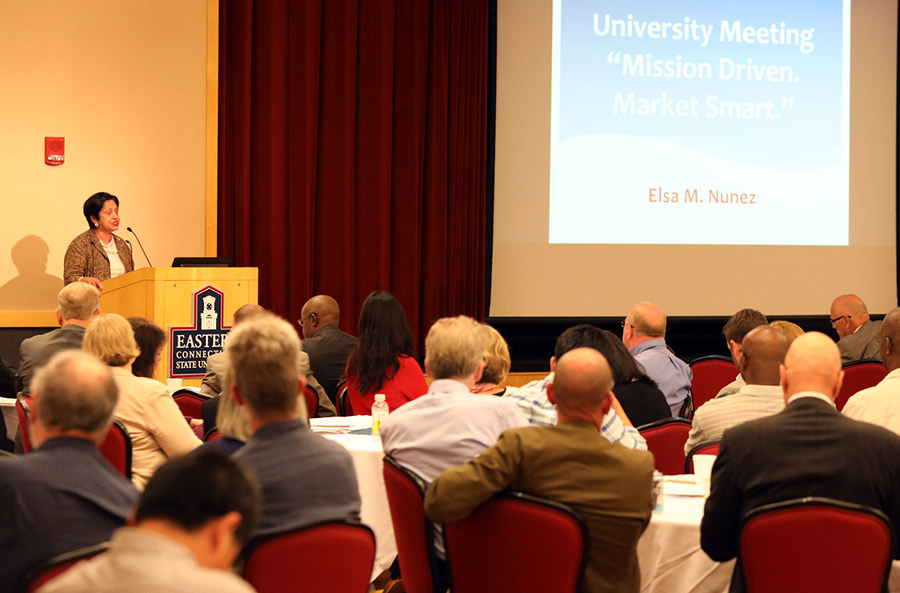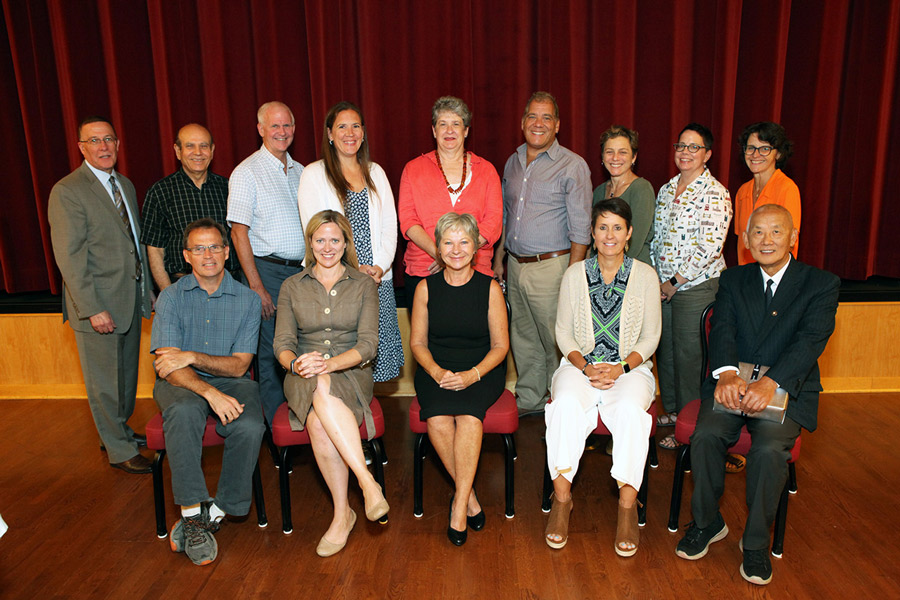- Apply
- Visit
- Request Info
- Give
State of the University: Eastern to be ‘Market Smart, Mission Driven’
Written by Michael Rouleau
Published on August 29, 2019
 The fall University Meeting opened the 2019-20 academic year on August 26 as President Elsa Núñez described the new reality of the higher education marketplace and laid out her vision for Eastern’s future. More than 300 faculty and staff converged on the Betty R. Tipton Room for the meeting, which also welcomed more than 30 new hires and honored 17 longstanding colleagues who are retiring or were receiving service awards.
The fall University Meeting opened the 2019-20 academic year on August 26 as President Elsa Núñez described the new reality of the higher education marketplace and laid out her vision for Eastern’s future. More than 300 faculty and staff converged on the Betty R. Tipton Room for the meeting, which also welcomed more than 30 new hires and honored 17 longstanding colleagues who are retiring or were receiving service awards.
The theme of the president’s State of the University Address was “Market Smart; Mission Driven”—a strategy of responding to the changing higher education marketplace while remaining true to Eastern’s public liberal arts mission.
“The higher education marketplace is changing,” said Núñez, “as are the demographics of the people we serve, creating a new reality that knocks loudly at our door.”
Núñez described a reality that includes fewer students graduating from high school, declining state funding, and a new generation of young adults with different interests and expectations.
Speaking to declining state funding, she said that in 1990, more than 60 percent of Eastern’s operating budget was funded by the State of Connecticut. Now the university gets less than 40 percent.

Staff and faculty who were honored for years of service and retirement. Front row, left to right: Drew Hyatt (20 years), Kristalyn Salters-Pedneault (10 years), Jutta Ares (retirement), Denise Bierly (25 years), Weiping Liu (retirement). Back row: Walter Diaz (20 years), Mohd Rujoub (20 years), Jeffrey Danforth (retirement), Angela Bazin (20 years), Rita Malenczyk (25 years), David Pellgrini (20 years), Kim Dugan (20 years), Theresa Severance (20 years), Michelle Bacholle (20 years).
Despite these fiscal and demographic challenges, Núñez assured the audience that Eastern is on solid footing, as the university has managed its budget frugally in recent years by cautiously filling vacancies—hiring only the most essential student- and safety-focused positions. Eastern has also saved money through green-energy practices, cutting costs across campus and other initiatives of the Ad Hoc Budget Committee.
The past decade of fiscal restraint has resulted in a reserves fund of $28 million—the third largest in the state university system, albeit being the smallest school.
“Until now we have been able to grow our reserves without having to reach into our savings to balance the budget,” said Núñez. “This is not by choice, but this is exactly why we worked hard to build a healthy reserve. Without your past sacrifices, we would not be in position to do so.”
Causes for turning to the reserves fund this year include lower enrollment; a reduction in state funding for fringe benefits; pay raises as negotiated by bargaining units; the hiring of essential new staff; and increased utilities costs due to the reopening of two new buildings.
Núñez also listed ways the university can be “market smart.” She said Eastern can continue to offer new majors — citing recent additions such as health sciences, criminology and finance — as well as modernize existing programs to ensure they meet workplace needs.
She also described increased recruitment efforts toward adult learners as well as tapping into new markets, such as New York, New Jersey and Puerto Rico.
Núñez particularly focused on the importance of retaining current students, outlining retention efforts that include a new advising model that engages all students—particularly transfer students and undeclared majors—and using data analytics to track student progress.
In challenging times, Núñez emphasized the importance of staying “mission driven”—offering a public liberal arts education with a focus on applied learning.
“We believe that the liberal arts offer the best intellectual tools we can provide students, skills highly sought by U.S. employers,” she said. Priorities moving forward include ensuring that all students experience hands-on learning — such as internships and research — and know how to articulate their education when applying for jobs.
Speaking to the “public” aspect of a state university, Núñez said, “Our responsibility to the citizens of Connecticut and to serving students from all walks of life is the bedrock of our mission.”
The president said that Eastern will maintain its high admission standards. “We can be elite without being elitist,” she said, pointing out that 30 percent of the student body are people of color and 88 percent of students receive financial aid.
“This moment in our history will define our future,” said Núñez in closing. “We have an opportunity to forge a new identity, focused on improving the quality of every aspect of our educational enterprise, while staying true to the public, liberal arts and experiential learning elements of our mission.”


